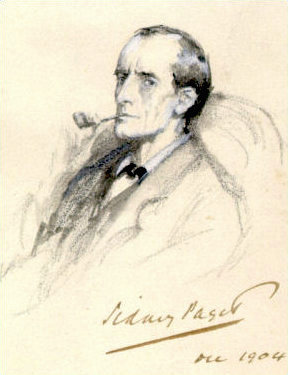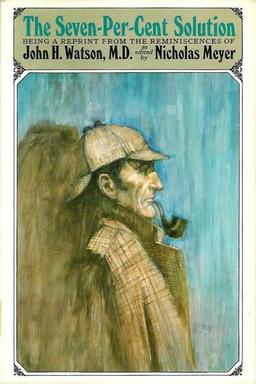Related Research Articles

Sherlock Holmes is a fictional detective created by British author Arthur Conan Doyle. Referring to himself as a "consulting detective" in the stories, Holmes is known for his proficiency with observation, deduction, forensic science and logical reasoning that borders on the fantastic, which he employs when investigating cases for a wide variety of clients, including Scotland Yard.
The Wold Newton family is a literary concept derived from a form of crossover fiction developed by the American science fiction writer Philip José Farmer.

Mycroft Holmes is a fictional character appearing in stories written by Sir Arthur Conan Doyle from 1893 to 1908. The elder brother of detective Sherlock Holmes, he is a government official and a founding member of the Diogenes Club. Mycroft is described as having abilities of deduction and knowledge exceeding even those of his brother, though their practical use is limited by his dislike of fieldwork.

The Seven-Per-Cent Solution: Being a Reprint from the Reminiscences of John H. Watson, M.D. is a 1974 novel by American writer Nicholas Meyer. It is written as a pastiche of a Sherlock Holmes adventure, and was made into a film of the same name in 1976.

The Diogenes Club is a fictional gentlemen's club created by Sir Arthur Conan Doyle and featured in several Sherlock Holmes stories, such as 1893's "The Adventure of the Greek Interpreter". It seems to have been named after Diogenes the Cynic and was co-founded by Sherlock's indolent elder brother Mycroft Holmes.

The Canary Trainer: From the Memoirs of John H. Watson is a 1993 Sherlock Holmes pastiche by Nicholas Meyer. Like The Seven Percent Solution and The West End Horror, The Canary Trainer was published as a "lost manuscript" of the late Dr. John H. Watson. In "The Adventure of Black Peter", an original Arthur Conan Doyle Holmes story from 1904, Watson mentions that his companion recently arrested "Wilson, the notorious canary-trainer, which removed a plague-spot from the East-End of London." This Wilson is not related to the eponymous character of Meyer's novel. Meyer's "trainer" is Erik, the principal figure of Gaston Leroux's 1910 novel The Phantom of the Opera. It is from this unchronicled tale that The Notorious Canary Trainers take their name.

Detective Inspector G. Lestrade, or Mr. Lestrade, is a fictional character appearing in several of the Sherlock Holmes stories written by Arthur Conan Doyle. Lestrade's first appearance was in the first Sherlock Holmes story, the novel A Study in Scarlet, which was published in 1887. The last story in which he appears is the short story "The Adventure of the Three Garridebs", which was first published in 1924 and was included in the final collection of Sherlock Holmes stories by Doyle, The Case-Book of Sherlock Holmes.
Solar Pons is a fictional detective created by August Derleth as a pastiche of Arthur Conan Doyle's Sherlock Holmes.
The stories of Sherlock Holmes by Sir Arthur Conan Doyle have been very popular as adaptations for the stage, and later film, and still later television. The four volumes of the Universal Sherlock Holmes (1995) compiled by Ronald B. De Waal lists over 25,000 Holmes-related productions and products. They include the original writings, "together with the translations of these tales into sixty-three languages, plus Braille and shorthand, the writings about the Writings or higher criticism, writings about Sherlockians and their societies, memorials and memorabilia, games, puzzles and quizzes, phonograph records, audio and video tapes, compact discs, laser discs, ballets, films, musicals, operettas, oratorios, plays, radio and television programs, parodies and pastiches, children's books, cartoons, comics, and a multitude of other items — from advertisements to wine — that have accumulated throughout the world on the two most famous characters in literature."
Sherlock Holmes has long been a popular character for pastiche, Holmes-related work by authors and creators other than Arthur Conan Doyle. Their works can be grouped into four broad categories:
Many writers make references to Sir Arthur Conan Doyle's famous literary creation, the detective Sherlock Holmes, and these often become embedded within popular culture. While Holmes exists predominantly in the context of Victorian-era London, he has been mentioned in such outre contexts as the 22nd century or hunting aliens or supernatural enemies. These references are in addition to the innumerable passing references to Sherlock Holmes made in many literary and cinematic works, such as the labeling of a person as a "Sherlock", whether in reference to their intelligence.
"A Study in Emerald" is a short story written by British fantasy and graphic novel author Neil Gaiman. The story is a Sherlock Holmes pastiche transferred to the Cthulhu Mythos universe of horror writer H. P. Lovecraft. Gaiman describes it as "Lovecraft/Holmes fan fiction". It won the 2004 Hugo Award for Best Short Story. The title is a reference to the Sherlock Holmes novel A Study in Scarlet.

Traditionally, the canon of Sherlock Holmes consists of the 56 short stories and four novels written by Sir Arthur Conan Doyle. In this context, the term "canon" is an attempt to distinguish between Doyle's original works and subsequent works by other authors using the same characters.

The Enola Holmes Mysteries is a young adult fiction series of detective novels by American author Nancy Springer, starring Enola Holmes as the 14-year-old sister of an already famous Sherlock Holmes, twenty years her senior. There are nine books in the series, and one short story all written from 2006–2023. This pastiche series borrows characters and settings from the established canon of Sherlock Holmes, but the Enola character is Springer's creation and specific to this series.
Leslie S. Klinger is an American attorney and writer. He is a noted literary editor and annotator of classic genre fiction, including the Sherlock Holmes stories and the novels Dracula, Frankenstein, and Strange Case of Dr. Jekyll and Mr. Hyde as well as Neil Gaiman's The Sandman comics, Alan Moore's and Dave Gibbons's graphic novel Watchmen, the stories of H.P. Lovecraft, and Neil Gaiman's American Gods.
This article describes minor characters from the Sherlock Holmes stories by Sir Arthur Conan Doyle, and from non-canonical derived works. The list excludes the titular character as well as Dr. Watson, Professor Moriarty, Inspector Lestrade, Mycroft Holmes, Mrs. Hudson, Irene Adler, Colonel Moran, the Baker Street Irregulars, and characters not significant enough to mention.
"The Empty Hearse" is the first episode of the third series of the BBC television series Sherlock. It was written by Mark Gatiss and stars Benedict Cumberbatch as Sherlock Holmes, Martin Freeman as Dr John Watson, and Mark Gatiss as Mycroft Holmes. It also marks the first appearance of Amanda Abbington as Mary Morstan and Lars Mikkelsen as Charles Augustus Magnussen.
"The Final Problem" is the third episode of the fourth series of the British television series Sherlock and the thirteenth episode overall. The episode was first broadcast on BBC One, PBS, Channel One and 1+1 on 15 January 2017.

Mycroft Holmes is a mystery novel by Kareem Abdul-Jabbar and Anna Waterhouse. It involves Sir Arthur Conan Doyle's character of Mycroft Holmes, the older brother of Sherlock Holmes, solving a mystery early in his career as a government official. It is Abdul-Jabbar's first adult novel.
References
- ↑ Cole, Sean (December 1, 2005). "Sherlock Holmes Fans Play 'Great Game'". All Things Considered . Retrieved June 5, 2012.
- ↑ Britt, Ryan (August 29, 2016). "The First Modern Fandom Brought Sherlock Holmes Back from the Dead". Inverse . Retrieved December 11, 2023.
- 1 2 Dorothy L. Sayers, Unpopular Opinions (London: Victor Gollancz, 1946), 7.
- ↑ Knox, Ronald, "Studies in the Literature of Sherlock Holmes, in: Essays in satire. London: Sheed & Ward, 1928.
- ↑ Roberts, S.C., A note on the Watson problem. Cambridge: University Press, 1929.
- ↑ Blakeney, T.S., Sherlock Holmes: Fact or Fiction?. London: John Murray, 1932.
- ↑ McDonald, Thomas L. The Great Game - Sherlock Holmes Devotees Get a New Bible. Games . Issue 208 (Vol. 29, No. 2). Pp.65-67. March 2005.
- ↑ Starrett, Vincent (1933). The Private Life of Sherlock Holmes . Macmillan Co.
- ↑ Bell, H.W. (1932). Sherlock Holmes and Dr. Watson. The Chronology of Their Adventures. Constable & Co.
- ↑ Dex (April 8, 2003). "Did Sherlock Holmes Really Exist?". The Straight Dope . Retrieved June 3, 2012.
- ↑ Asher-Perrin, Emmet (December 28, 2011). "Do Your Own Detecting: Sherlock Holmes and the Adventure of Tricky Continuity". Tor.com . Tor Books . Retrieved June 3, 2012.
- ↑ Baring-Gould, William S., Sherlock Holmes of Baker Street: A Biography of the World's First Consulting Detective . London: Rupert Hart-Davis, 1962.
- ↑ Conan Doyle, Sir Arthur, Memories and Adventures. London: Hodder & Stoughton, 1924.
- ↑ Howell, Cory (September 24, 2014). "Sherlock Holmes and the Wold Newton Universe". I Hear of Sherlock Everywhere. Retrieved December 21, 2019.
- ↑ Yon, Mark (2 November 2019). "Sherlock Holmes and the Christmas Demon by James Lovegrove". sffworld.com. Retrieved 20 December 2019.